George Cole stands as a significant figure in the landscape of 19th-century British art. Born in Portsmouth on January 15, 1810, and passing away in London on September 7, 1883, Cole forged a successful career as a painter of landscapes, animals, and occasionally portraits, despite lacking formal artistic training. His journey from humble beginnings to becoming a respected member of the London art establishment, known particularly for his evocative depictions of the English countryside, is a testament to his innate talent and dedication. He became one of the most popular landscape painters of his era, celebrated for capturing the light, atmosphere, and rural character of Southern England.
Early Life and Artistic Awakening in Portsmouth
George Cole's origins were modest. He was the son of James Cole and Elizabeth Parker, and his early life in Portsmouth offered little indication of his future artistic prominence. The family was not affluent, and consequently, George did not receive a formal education in the arts or otherwise. Instead, his artistic abilities were nurtured through observation and relentless self-study. His formative years were marked by practical work rather than academic pursuits. Following the death of his mother when he was just nine years old, he moved with his father within Portsmouth.
His connection to the maritime world of Portsmouth provided an unlikely, yet formative, entry point into the world of pigments and brushes. The Cole family had connections to the Portsmouth Naval Dockyard, a bustling hub of activity. Young George found employment there, initially working as an apprentice ship painter. This role involved more than just applying protective coats of paint; it included decorative work within the ships' cabins, encompassing the painting of figures and landscapes, as well as specialized tasks like gilding. This practical experience, though far removed from the fine art academy, undoubtedly honed his skills in handling materials and understanding visual composition.
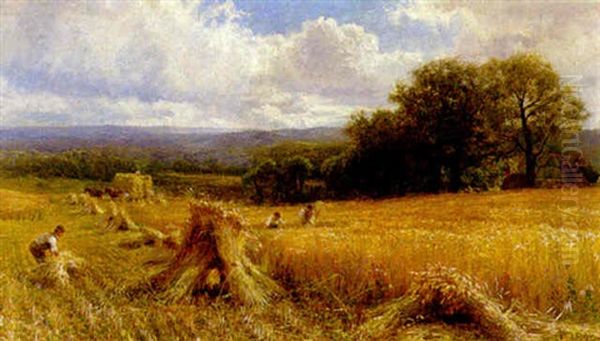
During these early years, Cole began experimenting with art in his own time. He initially focused on painting advertising posters, a common starting point for aspiring commercial artists. He also developed an interest in animal painting, a genre that would remain a recurring feature in his later landscape work. His early artistic endeavours also included portraiture, demonstrating a versatility that would serve him well. Living and working in Portsmouth, he likely had opportunities to view works by established artists, perhaps including Dutch Masters whose influence is often noted in his later style, possibly seen in local collections.
The Transition to Landscape and Early Exhibitions
While Cole initially earned a living through practical painting and portraits, his true passion lay in capturing the natural world. By the late 1830s, he began to shift his focus decisively towards landscape painting. This transition marked the beginning of his serious artistic career. He started exhibiting his work in 1838, with his painting The Farm Yard being shown at the prestigious Society of British Artists (SBA) galleries on Suffolk Street in London. This was a significant step, moving his work from a local context to the competitive London art scene.
His London debut continued in 1840 when he exhibited at the British Institution, another important venue for artists seeking recognition. These early exhibitions primarily featured his animal and landscape subjects, showcasing his burgeoning talent for capturing rural life. Cole was deeply inspired by the English landscape tradition, studying and sometimes imitating the works of earlier masters. He particularly admired the atmospheric effects achieved by J.M.W. Turner and the naturalism of John Constable. The influence of earlier landscape painters like David Cox is also discernible in his handling of light and scenery.
The 1840s saw Cole consolidating his reputation. He continued to develop his technique, focusing on the accurate depiction of nature, combined with an ability to convey mood and atmosphere. His self-directed study involved close observation of the countryside around him, particularly the landscapes of Southern England which would become his most beloved subject matter. He painted scenes featuring rivers, coastlines, rolling hills, and the farms and villages nestled within them.
Recognition and Establishment in the Art World
The year 1849 marked a crucial milestone in George Cole's career. He made his debut at the Royal Academy of Arts (RA) Summer Exhibition with a painting titled The Gravel Pit (sometimes referred to as Donkeys in a Gravel Pit). Exhibiting at the Royal Academy was, and remains, a significant mark of achievement for any British artist. This success brought his work to a wider, national audience and cemented his status as a serious landscape painter.
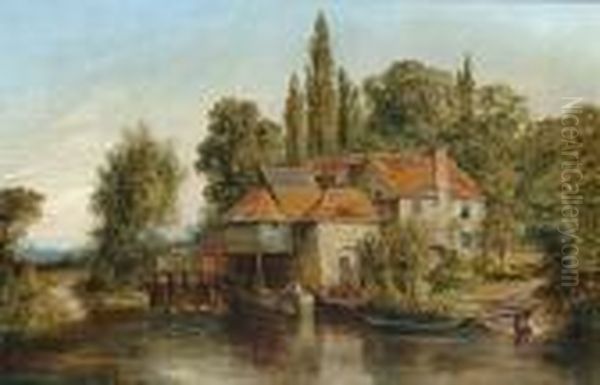
Following his RA debut, Cole's career gained considerable momentum. In 1850, he was elected a member of the Society of British Artists (SBA), the institution where he had first exhibited in London twelve years earlier. This membership provided him with a regular platform to showcase his work and connected him more closely with the London art community. He remained a loyal and active member of the SBA throughout his career.
The 1850s saw Cole fully dedicate himself to landscape painting. His style matured, characterized by a confident handling of paint, rich colour palettes, and a keen eye for detail. He travelled within Britain to gather inspiration, venturing beyond his familiar Southern England haunts. In 1851, he visited the Moselle River region in Germany, bringing back sketches that informed paintings exhibited at the Royal Academy in 1853. Later, in the 1860s, he undertook regular trips to Scotland, North Wales, and Yorkshire, broadening his range of subjects and further developing his ability to capture diverse landscapes and weather conditions.
His growing reputation was further solidified by official recognition. In 1864, he received a prestigious silver medal from the British Institution for one of his landscape paintings, acknowledging the high quality and appeal of his work. His standing within the Society of British Artists continued to rise, culminating in his election as Vice-President in 1867, a position reflecting the high esteem in which he was held by his peers.
Mature Style: Capturing the English Countryside
George Cole's mature artistic style is synonymous with idyllic yet naturalistic portrayals of the British landscape, particularly the southern counties like Hampshire, Surrey, and Sussex. He possessed a remarkable ability to capture the interplay of light and shadow, the textures of foliage and earth, and the specific atmosphere of different times of day and seasons. His works often convey a sense of peace and harmony, celebrating the enduring beauty of rural England.
He frequently included animals, especially cattle and sheep, in his landscapes. These were not mere accessories but integral parts of the scene, often depicted with great care and anatomical accuracy, harking back to his early interest in animal painting. Cattle watering at riverbanks or resting in sun-dappled fields became signature motifs. Works like his depictions of Windsor Castle often focused on the Thames riverbanks nearby, featuring herds of cattle, rather than just the architecture itself. He masterfully integrated figures, typically farm workers or country folk, into his compositions, adding narrative interest and a sense of lived reality to the scenes.
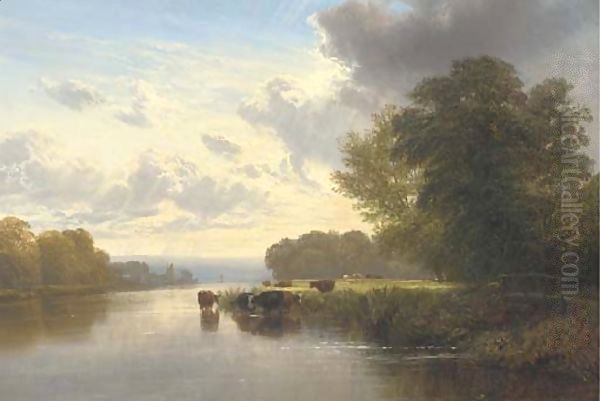
His technique involved careful layering of paint to achieve depth and luminosity. While influenced by the dramatic skies of Turner and the earthy realism of Constable, Cole developed his own distinct voice. His landscapes often possess a warm, golden tonality, particularly in his depictions of late afternoon or harvest scenes. He excelled at rendering complex textures, from the rough bark of trees to the shimmering surface of water and the hazy distances of the English countryside. His compositions are typically well-balanced, leading the viewer's eye through pastoral vistas.
Cole often worked on large canvases, allowing him ample space to develop his detailed scenes and create immersive experiences for the viewer. His dedication to plein air sketching during his travels provided him with authentic source material, which he then worked up into finished paintings in his studio. This combination of direct observation and studio refinement contributed to the convincing naturalism and appealing finish of his works.
Representative Works
Throughout his long career, George Cole produced a substantial body of work. Several paintings stand out as representative of his style and achievements:
The Gravel Pit (1849): His Royal Academy debut piece, likely depicting a common rural scene with donkeys, showcasing his ability to find picturesque qualities in everyday subjects and his skill in animal painting within a landscape context.
Fern Carting (c. 1860s): This work exemplifies his interest in rural labour and the landscapes of Hampshire. It likely depicts the gathering of bracken, a common practice, set within a richly detailed woodland or heathland scene, demonstrating his mature landscape style.
Harting Coombe (1873): Representing his focus on specific locations in Southern England, this painting captures a valley landscape, probably in the South Downs near Harting. It would showcase his skill in rendering topography, foliage, and atmospheric perspective.
A Cornfield (1876): A classic Cole subject, depicting the quintessential English harvest scene. Such works often feature golden fields, farm workers, and a sense of abundance, rendered with his characteristic warmth and attention to detail.
The Pool of London (exhibited RA 1888, painted earlier): Although exhibited posthumously after being purchased by the Chantrey Bequest, this is considered one of Cole's major works. A large and ambitious painting depicting the bustling river traffic on the Thames in London, it shows his versatility in tackling complex urban, as well as rural, landscapes. It is now part of the Tate collection.
Windsor Castle from the Thames (various versions): Cole painted views featuring Windsor Castle multiple times, often focusing on the pastoral foreground along the river, with cattle watering – a recurring and popular theme that combined landscape, animal painting, and a famous landmark.
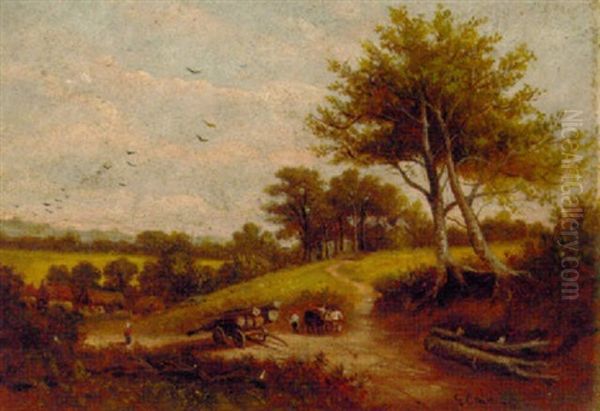
These works, among many others, highlight Cole's dedication to capturing the essence of the English landscape, its activities, and its inhabitants, rendered with technical skill and genuine affection.
The Cole Family: An Artistic Dynasty
George Cole's artistic life was closely intertwined with his family. He married Eliza Vicat, who was herself noted as an artist, creating an artistic household. Together they had three children. Their most famous offspring was their son, George Vicat Cole (1833-1893), who followed directly in his father's footsteps to become one of the most successful landscape painters of the later Victorian era.
George Vicat Cole received his initial artistic training from his father. The two shared a close relationship, both personally and professionally. They often sketched together, and the elder Cole's style and subject matter profoundly influenced his son's early work. George Vicat Cole rapidly developed his own distinct style, often favouring more dramatic lighting and perhaps a slightly looser brushwork than his father, but the foundation laid by George Cole was undeniable.
George Vicat Cole achieved even greater official recognition than his father, becoming a full member of the Royal Academy (RA) in 1880. Father and son represented a significant force in the British landscape painting scene for several decades. Their shared focus on the beauty of the English countryside, particularly the Thames Valley and Surrey, helped to popularize this genre among Victorian audiences. The success of George Vicat Cole further cemented the Cole family name in the annals of British art history.
Contemporaries and Artistic Context
George Cole worked during a vibrant period in British art. The Victorian era saw a huge demand for landscape painting, fuelled by a growing middle class, a sense of national pride, and a romantic appreciation for nature. Cole operated alongside numerous other talented artists exploring similar themes.
His work can be situated within the broader tradition of British naturalism, alongside contemporaries who also focused on detailed and affectionate renderings of the landscape and rural life. Artists like Benjamin Williams Leader, known for his Worcestershire landscapes, and Myles Birket Foster, celebrated for his charming watercolour scenes of country life, shared a similar public appeal. Thomas Sidney Cooper was the preeminent painter of cattle, and Cole's skill in this area placed him in dialogue with Cooper's work, though Cole always integrated animals within a broader landscape context.
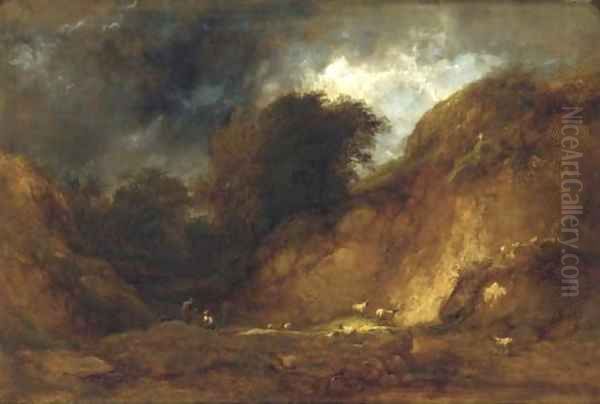
Other notable landscape painters of the period included William Shayer Sr., who painted scenes of the New Forest and coastal life often featuring figures and animals, Frederick Richard Lee, known for his tranquil river scenes and coastal views, and the influential John Linnell, whose visionary landscapes often carried religious undertones. Older contemporaries like Thomas Creswick and the marine painter Clarkson Stanfield were also prominent figures whose work formed part of the artistic environment in which Cole developed.
While Cole admired and learned from giants like Turner and Constable, his own work generally avoided the sublime drama of the former and the proto-Impressionistic looseness of the latter's sketches. Cole carved out a niche for highly finished, accessible, and picturesque landscapes that resonated strongly with Victorian tastes for detailed realism combined with gentle sentiment. He was a central figure in the mainstream of popular landscape art during his lifetime.
Later Life and Enduring Legacy
George Cole remained active as a painter well into his later years, continuing to exhibit regularly at the Society of British Artists, the Royal Academy, and other venues. He maintained his studio in London, though he continued to draw inspiration from his travels and his deep connection to the countryside. His reputation as a leading landscape painter remained secure throughout the 1860s and 1870s.
He passed away in London on September 7, 1883, at the age of 73. His death marked the end of a long and productive career dedicated to celebrating the beauty of the British landscape. He left behind a significant body of work that had earned him both critical acclaim and popular success.
Today, George Cole's paintings are held in numerous public collections, including the Victoria and Albert Museum in London, the Tate Britain (holding the Chantrey Bequest work The Pool of London), and various regional galleries, particularly the Portsmouth Art Gallery in his hometown. His works also frequently appear on the art market, attesting to their continued appeal to collectors.
His legacy lies in his contribution to the rich tradition of British landscape painting. As a largely self-taught artist who achieved significant success, he serves as an inspiring example of talent and perseverance. He masterfully captured the specific character and atmosphere of the English countryside, particularly Southern England, creating works that are both detailed records of a landscape undergoing change and timeless evocations of rural beauty. Through his own work and his influence on his successful son, George Vicat Cole, he played a notable role in shaping the course of landscape art in the Victorian era.
Conclusion
George Cole's journey from a ship painter's apprentice in Portsmouth to a celebrated London artist is a remarkable story. Without the benefit of formal training, he cultivated his innate talent through observation, practice, and a deep love for the natural world. His paintings of the English landscape, characterized by their warmth, detail, and atmospheric sensitivity, captured the hearts of the Victorian public and earned him a respected place among his peers. His depictions of sunlit fields, tranquil rivers, and gentle pastoral scenes remain enduring images of 19th-century Britain, securing his position as a significant, self-made master of the landscape genre.